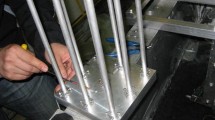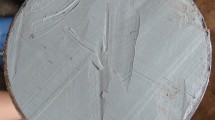Abstract
Little attention was paid to the mi cro-structural investigation, although a number of geotechnical in vestigations have been performed on pusan clay since early 1990s. Particularly, pore size distribution (PSD) which affects permeability, consolidation, and strength and so on has seldom been investigated on the clay. In order to examine the PSD during consolidation, mercury intrusion porosimetry (MIP) investigation was carried out on intact clay and also the one-dimensional consolidated clays with various stress levels, as well as scanning electron microscope (SEM). As the result, the PSD of intact clay was observed in depth and also the change with the applied consolidation stress levels. It was recognized that the PSD are remarkably different for the upper and lower clays, but the compression occurred during consolidation stress is dominantly resulted from a decrease in the inter-aggregate (large) pore spaces (larger than 2 μm in diameter). Moreover, characteristics of the PSD were effectively represented by the mean pore size (D p50).
Similar content being viewed by others
References
Chung, S.G., Giao, P.H., Kim, G.J., and Leroueil, S. (2002). “Geotechnical characteristics of Pusan clays.”Canadian Geotechnical Journal, Vol. 39, pp. 1050–1060.
Chung, S.G., Baek, S.H., Ryu, C.K., and Kim, S.W. (2003). “Theme Lecture: Geotechnical characterization of Pusan clays”.Proceeding of Korea-Japan Joint Workshop, Characterization of Thick Clay Deposits, Reclamation and Port Construction, Busan, Korea, 8–10 April: 3–44.
Chung, S.G., Kwag, J.M., Giao, P.H., Back, S.H., and Prasad, K.N. (2004). “A study of soil disturbance of Pusan clays with reference to drilling, sampling and extruding.”Geotechnique, Vol. 54, No. 1, pp. 61–65.
Chung, S.G., Ryu, C.K., Jo, K.Y., and Huh, D.Y. (2005). “Geological and geotechnical characteristics of marine clays at the new Busan port.”Marine Georesources and Geotechnology, Vol. 23, No. 3, pp. 235–251.
Chung, S.G. (2005). “Keynote Lecture: Sampling techniques and their effects in characterizing of Pusan clay.”Proceedings of International Conf on Civil and Environmental Engineering, ICCEE-2005, Higashi-Hiroshima, Hiroshima University, Japan, Oct 26–27: 29–59.
Chung S.G., Jang, W.Y., Ninjgarav, E., and Ryu, C.K. (2006a). “Compressibility characteristics associated with depositional environment of Pusan clay in the Nakdong River estuary.”Journal of the Korean Geotechnical Society, Vol. 22, No. 12, pp. 37–65 (in Korean).
Chung S.G., Jang, W.Y., Ninjgarav, E., and Kim, S.R. (2006b). “Permeability characteristics of Pusan clay from laboratory tests.”Journal of the Korean Geotechnical Society, Vol. 22, No. 11, pp. 133–142 (in Korean).
Delage, P., Tessier, D., and Marcel-Audiguier, M. (1982). “Use of the Cryoscan apparatus for observation of freeze fractured surfaces of a sensitive Quebec clay in scanning electron microscopy.”Canadian Geotechnical Journal, Vol. 19, pp. 111–114.
Delage, P. and Lefebvre, G. (1984). “Study of the structure of a sensitive Champlain clay and its evolution during consolidation.”Canadian Geotechnical Journal, Vol. 21, pp. 21–35.
Garcia-Bengochea, I., Lovell, C.W. and Altschaeffl, A.G. (1979). “Pore distribution and permeability of silty clays.”J. of the Goetech. Engrg., ASCE, Vol. 105, pp. 839–856.
Juang, C.H. and Holtz, R.D. (1986). “Fabric, pore size distribution, and permeability of sandy soils.”J. of the Geotech. Engrg., ASCE, Vol. 112, pp. 855–868.
Lapierre, C., Leroueil, S., and Locat, J. (1990). “Mercury intrusion and permeability of Louiseville clay.”Canadian Geotechnical Journal, Vol. 27, pp. 761–773.
Mesri, G., Kwan Lo, D.O. and Feng, T.W. (1994). “Settlement of embankments on soft clays.”Proc. of Settlement ’94. ASCE, Geotechnical Special Publication (40), pp. 8–56.
Ninjgarav, E. (2006).Consolidation and Permeability Characteristics of Pusan Clay. PhD Thesis, Dong-A University, Busan Korea.
Tanaka, H., Dinesh, R., and Tanaka, M. (2003). “Pore Size distribution of clayey soils measured by mercury intrusion Porosimetry and its relation to hydraulic conductivity.”Soils and Foundations Vol. 43, No. 6, pp. 63–73.
Watabe, Y., Leroueil, S., and Le Bihan, I.P. (2000). “Influence of compaction conditions on pore-size distribution and saturated hydraulic conductivity of a glacial till.”Canadian Geotechnical Journal., Vol. 27, pp. 761–773.
Author information
Authors and Affiliations
Corresponding author
Rights and permissions
About this article
Cite this article
Ninjgarav, E., Chung, SG., Jang, WY. et al. Pore size distribution of pusan clay measured by mercury intrusion porosimetry. KSCE J Civ Eng 11, 133–139 (2007). https://doi.org/10.1007/BF02823892
Received:
Accepted:
Issue Date:
DOI: https://doi.org/10.1007/BF02823892




